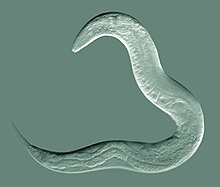microscopic roundworm. Many are beneficial organisms. but some feed on plant tissues and may cause disease or damage.
| Roundworm | |
|---|---|

| |
| Caenorhabditis elegans, a model species of roundworm | |
| Scientific classification | |
| Kingdom: | Animalia |
| Clade: | Nematoida |
| Phylum: | Nematoda Diesing, 1861 |
| Classes | |
|
(see text) | |
| Synonyms | |
| |
The nematodes (UK: /ˈnɛmətoʊdz/, US: /ˈniːməˌtoʊdz/) or roundworms constitute the phylum Nematoda (also called Nemathelminthes). They are a diverse animal phylum inhabiting a broad range of environments. Taxonomically, they are classified along with insects and other moulting animals in the clade Ecdysozoa, and unlike flatworms, have tubular digestive systems with openings at both ends.
Nematode species can be difficult to distinguish from one another. Consequently, estimates of the number of nematode species described to date vary by author and may change rapidly over time. A 2013 survey of animal biodiversity published in the mega journal Zootaxa puts this figure at over 25,000. Estimates of the total number of extant species are subject to even greater variation. A widely referenced article published in 1993 estimated there may be over 1 million species of nematode, a claim which has since been repeated in numerous publications, without additional investigation, in an attempt to accentuate the importance and ubiquity of nematodes in the global ecosystem (rather than as a sign of agreement with the estimated taxonomic figure). Many other publications have since vigorously refuted this claim on the grounds that it is unsupported by fact, and is the result of speculation and sensationalism. More recent, fact-based estimates have placed the true figure closer to 40,000 species worldwide.
Nematodes have successfully adapted to nearly every ecosystem: from marine (salt) to fresh water, soils, from the polar regions to the tropics, as well as the highest to the lowest of elevations. They are ubiquitous in freshwater, marine, and terrestrial environments, where they often outnumber other animals in both individual and species counts, and are found in locations as diverse as mountains, deserts, and oceanic trenches. They are found in every part of the earth's lithosphere, even at great depths, 0.9–3.6 km (3,000–12,000 ft) below the surface of the Earth in gold mines in South Africa. They represent 90% of all animals on the ocean floor. Their numerical dominance, often exceeding a million individuals per square meter and accounting for about 80% of all individual animals on earth, their diversity of lifecycles, and their presence at various trophic levels point to an important role in many ecosystems. They have been shown to play crucial roles in polar ecosystem. The roughly 2,271 genera are placed in 256 families. The many parasitic forms include pathogens in most plants and animals. A third of the genera occur as parasites of vertebrates; about 35 nematode species occur in humans.
Nathan Cobb, a nematologist, described the ubiquity of nematodes on Earth as thus:
In short, if all the matter in the universe except the nematodes were swept away, our world would still be dimly recognizable, and if, as disembodied spirits, we could then investigate it, we should find its mountains, hills, vales, rivers, lakes, and oceans represented by a film of nematodes. The location of towns would be decipherable, since for every massing of human beings, there would be a corresponding massing of certain nematodes. Trees would still stand in ghostly rows representing our streets and highways. The location of the various plants and animals would still be decipherable, and, had we sufficient knowledge, in many cases even their species could be determined by an examination of their erstwhile nematode parasites.
